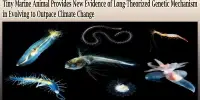A significant puzzle in evolution is how life manages to survive in unpredictable and severe settings. Extreme settings for aquatic species include those with limited water, such as the central Australian deserts. According to experts, adaptations in the genome linked to the extremely dry environments of Australia’s outback guarantee desert fish populations thrive in severe conditions.
The subject of how life adapts to severe or challenging circumstances is a recurring one in evolutionary biology. Arid conditions, such as the central Australian desert region, can be quite severe, especially for fish.
According to scientists from Flinders University’s Molecular Ecology Lab and their collaborators from University Laval in Quebec and the University of Canberra, adaptations in the genome linked to the extremely dry conditions of Australia’s outback ensure desert fish populations survive in harsh conditions.
“It’s a mystery how communities of aquatic creatures survive in harsh desert conditions,” noted the study’s authors. “When conditions are favorable, individuals frequently breed and disperse. Theory predicts that adaptive ability in limited populations, such as desert fishes, will be poor.”
The researchers concentrated on Desert Rainbowfish (Melanotaenia splendida tatei) populations collected from across the Australian desert. Desert Rainbowfish genomic variations were matched to data from satellite pictures about the amount of surface water in central Australia.
It’s a mystery how communities of aquatic creatures survive in harsh desert conditions. When conditions are favorable, individuals frequently breed and disperse. Theory predicts that adaptive ability in limited populations, such as desert fishes, will be poor.
Professor Luciano Beheregaray
The researchers matched genetic variations from distinct populations of desert rainbow fish to satellite photographs of water in central Australia. They discovered that rainbowfish populations from drier places were smaller but had a stronger ability to adapt to dry conditions.
“This flips the conventional wisdom that tiny populations are evolutionary dead-ends on its head. Life finds a way, even in the most harsh and unexpected conditions on the planet,” Professor Luciano Beheregaray remarked. They discovered that populations from the desert’s drier sections are more isolated and smaller, but have a greater ability to adapt to severe and arid circumstances.
“This flips the conventional wisdom that tiny populations are evolutionary dead-ends on its head. Even in the harshest and most unpredictable settings on the planet, life persists “Professor Luciano Beheregaray, Research Section Lead of Ecology, Evolution, and Environment at Flinders University, explains.

Fish out of water: Genomic insights into the persistence of rainbowfish populations in the desert (by Catherine Attard, Jonathan Sandoval-Castillo, Chris Brauer, Peter Unmack, David Schmarr, Louis Bernatchez, and Luciano Beheregaray, published in the journal Evolution) is arguably the first paper in the world to explain how fish can survive and evolve in a desert environment.
Maintaining a wide gene pool is vital for populations to evolve in response to environmental changes, but understanding how small populations of desert fish survive, particularly when located in isolated pockets of water, has remained a mystery.
“A narrow gene pool can lead to inbreeding and poor health, which is occasionally seen in endangered species,” explains Flinders University’s Molecular Ecology Lab lead author Dr. Catherine Attard. “However, we discovered that desert fish in Australia can survive by adapting to harsh surroundings, spawning, and spreading during rare flooding occurrences.”
When fish disperse over temporary streams and floodwaters, aridity-adapted genes can proliferate. These fish, along with their adaptive genetic make-up, are then prepared for the next drought. The most intriguing change was found in a gene that encodes a guanine nucleotide-binding protein. These proteins are employed in fish to sense salinity and water flow, as well as to adjust light sensitivity for vision. Different proteins found in fish from arid western areas may help them strengthen their environmental sensors.
Aridity-adapted genes may allow organisms to persist when dry regions expand and experience more intense climatic variations as a result of future climate change.
“A tiny gene pool can lead to inbreeding and poor health, as seen in endangered species,” research lead author Dr. Catherine Attard explained. “However, we discovered that desert fish in Australia can survive by adapting to harsh surroundings, spawning, and spreading during rare flooding occurrences.”
Surprisingly, despite the fact that the fish populations appear to be separated, gene flow occurs when periodic flooding unites distinct populations. This appears to be critical for the survival of these small populations.
“Our findings imply that adaptations and the conservation of genetic variation can occur even in tiny populations, as long as natural connection occurs during floods,” says Professor Beheregaray. The discovery that tolerance to severe settings occurs even in tiny populations has implications for climate change adaptation research and conservation science.
















